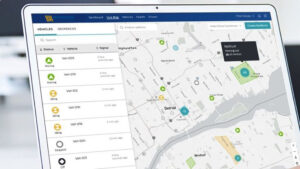At its core, asset monitoring is a systematic and technology-driven process focused on the remote tracking of physical assets using specialized hardware and software.
This encompasses the active oversight and management of a company’s tangible resources, with particular emphasis on their geographical location, operational status, current condition, and the extent to which they are being utilized.
Effective asset monitoring transcends the basic function of pinpointing an asset’s location; it extends to the capture and analysis of a range of critical parameters. These include detailed insights into how an asset is being used, the number of hours an engine has been running, adherence to scheduled maintenance routines, and even the monitoring of environmental factors that could impact an asset’s performance or integrity, such as temperature and humidity.
For telematic companies, the true value of an asset monitoring solution is underscored by its capacity to integrate a diverse spectrum of data points. This holistic approach provides a significantly more comprehensive and actionable understanding of an asset’s overall performance and current health, going far beyond the capabilities of simple location-based services. Telematic systems are inherently designed to collect and process a wide variety of data originating from vehicles and equipment. By extending this fundamental capability to encompass other types of assets, telematic providers can furnish their clients with exceptionally rich insights. This depth of data enables proactive asset management and optimization strategies that are simply not achievable with basic, standalone tracking solutions.
Telematics serves as the essential technological foundation for contemporary asset monitoring. It provides the crucial infrastructure required for the collection of data from tracking devices that are affixed to assets. This data acquisition is facilitated by a variety of technologies, most notably GPS for precise location tracking and an array of specialized sensors that capture information about an asset’s condition and usage. Furthermore, telematics provides the vital wireless communication networks—utilizing cellular, satellite, and other protocols—necessary for the seamless transmission of this collected data. This information is then relayed to a centralized software platform, which is often hosted in the cloud, where it undergoes sophisticated analysis and processing. The resulting insights are then presented to users in a clear, accessible, and easily understandable format. Through these intuitive software platforms, businesses gain the power of real-time visibility into the precise geographical location of their assets, their current operational status, and a multitude of key performance indicators. This level of insight empowers proactive asset management practices and supports well-informed decision-making across the organization.
Telematic companies occupy a uniquely advantageous position to deliver robust and effective asset monitoring solutions. This is primarily due to their existing possession of the fundamental infrastructure and specialized expertise in the critical areas of hardware, software, and network connectivity. These core competencies are essential for the successful collection, reliable transmission, and insightful analysis of asset-related data. Their established presence within the market and their existing relationships with a broad customer base provide a substantial advantage for expanding their service portfolios to include comprehensive asset monitoring capabilities.
It is important to distinguish between asset monitoring and inventory tracking. While both disciplines involve the systematic tracking of items, asset monitoring, or tracking, specifically concentrates on the physical assets that an organization owns, derives benefit from, or utilizes in its revenue-generating processes. This oversight extends throughout the entire lifecycle of these assets, from their initial acquisition to their eventual disposal. The types of assets typically monitored include vehicles used for transportation or operations, various pieces of equipment essential for production or service delivery, and specialized tools required for specific tasks. Inventory tracking, conversely, is primarily concerned with maintaining accurate records of items that have been procured from suppliers and are held in stock with the principal objective of being sold to customers or distributed as part of the business’s offerings. For telematic companies, it is, therefore, crucial to delineate between asset monitoring and inventory tracking in their service offerings and marketing materials. This distinction ensures that they effectively target the specific needs of their clients and avoid any potential confusion regarding the scope and intended purpose of their technological solutions. A clear understanding of the differing requirements of businesses seeking to manage their operational assets versus those focused on managing goods intended for sale allows telematics providers to tailor their solutions and communication strategies with precision. This ensures they are addressing the most relevant pain points with the most appropriate suite of features and functionalities.



